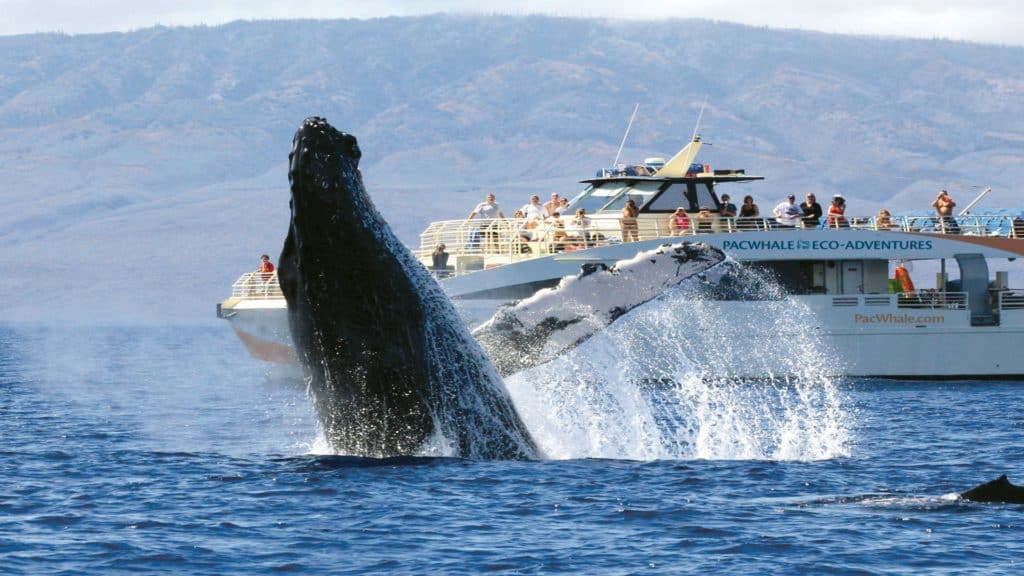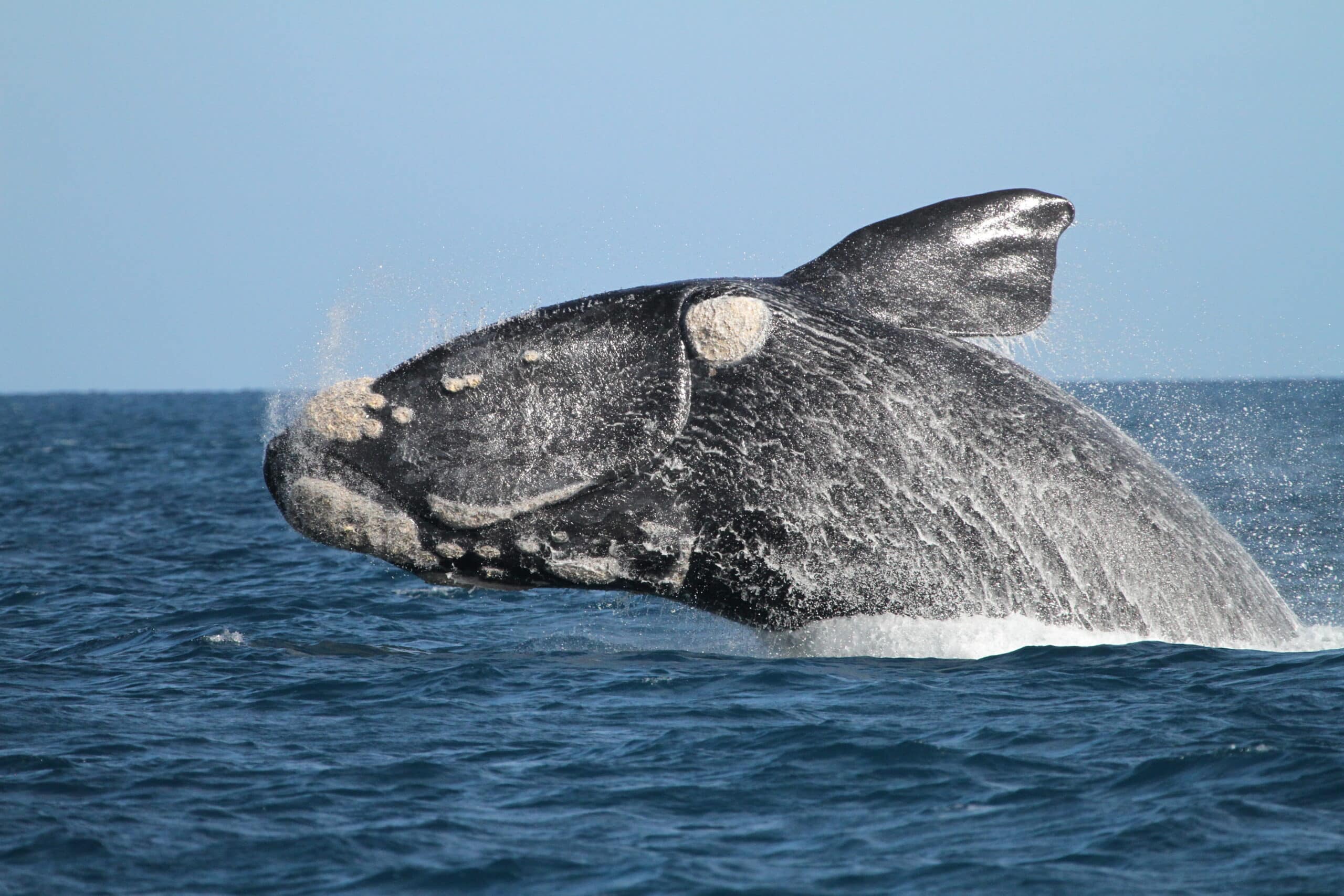Author: Conservation Coordinator Shelby Serra
EMBRACING RESPONSIBLE WHALE WATCHING
Although wildlife viewing is crucial to the conservation of animals, it can be detrimental if not properly conducted.
Few experiences rival the rush of seeing a whale breach from the bow of a boat or the playful escort of a pod of dolphins as the vessel churns through ocean waters. Observing nature’s majesty up close and personal not only inspires awe, it can drastically alter the footprint we leave as we journey through life. Although whales and dolphins face myriad threats in their natural environment, what if our desire for this intimate connection to marine mammals actually benefited ocean wildlife?
In our last series, we took a deep dive into policies that protect whales and dolphins from the dangers of marine debris. Now begins our plunge into how a multi-billion dollar industry holds the power to either help or hurt the whales.
FROM WHALE HUNTING TO WHALE WATCHING
The boat-based commercial whale-watching industry is relatively young, beginning in 1955 to view gray whales off the Southern California shoreline as they migrate to and from their breeding grounds along the Western Mexican coast (Hoyt 2014). At the time, the gray whale was recovering from very low numbers after the 19th century whaling era. As their numbers increased along the California coast, the whale became a symbol of the U.S. conservation movement in the late 1960s — a mere 65 years since whales began inspiring their own conservation.
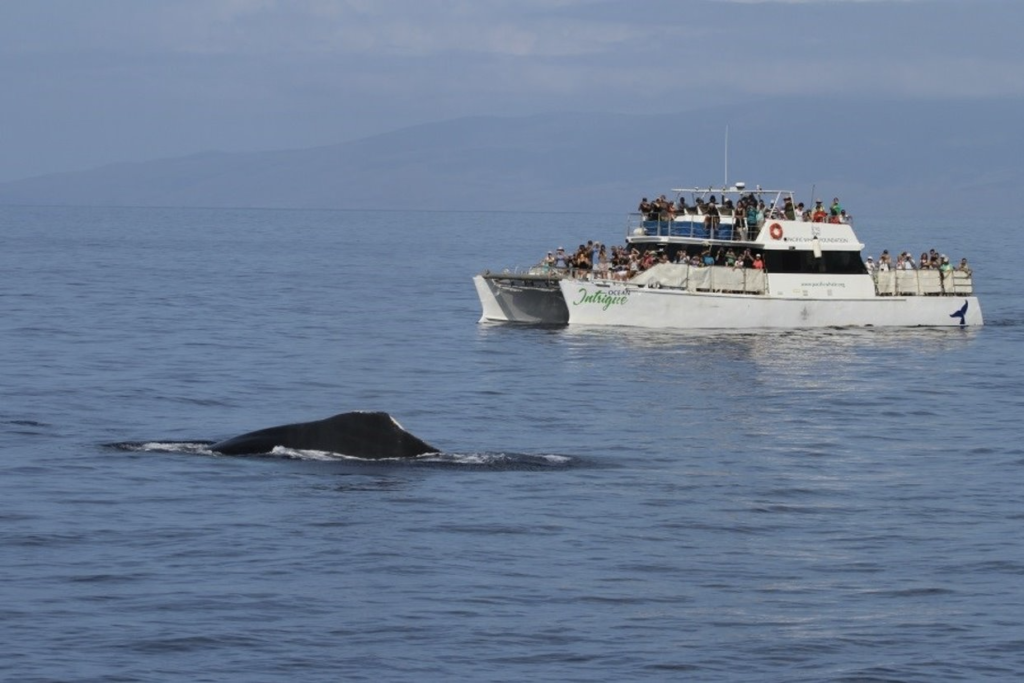
The whale-watching industry has the potential to not only encourage and support the conservation of these mammals, but also benefit the economy of the communities it serves. A far cry from its humble California beginnings, recent data compiled by the International Fund for Animal Welfare (IFAW) indicates 13 million people participated in whale watching in 119 countries and territories, generating $2.1 billion worldwide. When whale watching follows science-based guidelines, it can create a “win-win” for conservation and local populations that benefit from increased economic activity.
Despite the economic benefits, however, whale watching can also negatively impact the whales involved if not done properly. Fortunately, the risks posed by irresponsible whale watching can be mitigated with education and adherence to guidelines that encourage the preservation of the species involved.
A SLIPPERY SLOPE
Rules governing whale-watching behavior vary widely around the globe. While most areas have a set of guidelines (either official or voluntary) for operators to follow, compliance and enforcement is often spotty. Guidelines are developed either by the region’s Tourism Authority, nonprofit groups or the operators themselves. The discrepancy on who formulates these guidelines creates room for leniency, and lack of enforcement plays a significant role in the detrimental impacts of wildlife viewing. Studies have shown that vessel presence can impact cetacean behavior, and this behavior change can have short- and long-term consequences on an individual’s reproductive success and population size (Senigaglia 2016). Therefore, operator compliance plays a major role in ensuring the continued safety of the animals involved.
-

Antarctica -
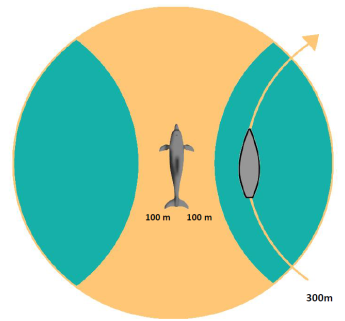
France -

Norway
Examples of vessel maneuverability guidelines
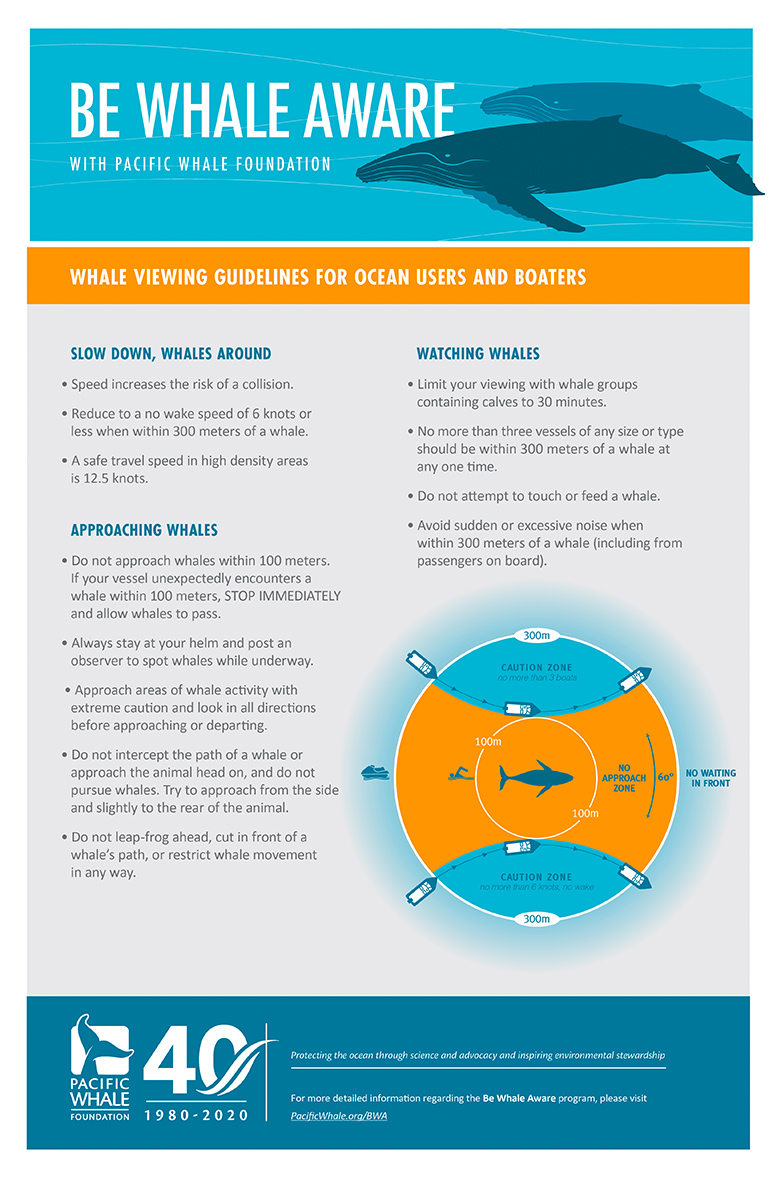
Most industry guidelines are voluntary and formatted as “codes of conduct.” The existence of these codes alone helps raise awareness for operators and whale watchers alike. PWF’s own Be Whale Aware & Dolphin Wise guidelines are an example of this, with specific guidelines that cover Hawaii, Australia and Ecuador, and general guidelines that stand as best practices for ocean users and boaters who wish to view whales and dolphins in the wild.
Although most countries have guidelines outlining specific rules for operators to follow, compliance and enforcement seem to be the biggest problem. Most of the countries with such guidelines also provide an easily digestible graphic illustrating how to maneuver a boat with respect to the animals encountered (figure 2). These guidelines generally include guidance on approach distance, directives to avoid harassment and excessive noise, as well as prohibitions on dumping garbage and other pollutants into the water. Although these are common across commercial operations, viewing guidelines and laws vary by region, state and species. For example, operators in Kenya, New Zealand and Colombia stipulate a “no wake” speed of approach, whereas Egypt, Australia and Gabon identify specific speeds, ranging from 3 to 7 knots.
In addition to variations across approach speed, approach distance also varies across the world. Understandably, the distance required when an operator approaches a whale or dolphin directly impacts the safety of the animal encountered. In the U.S., the Marine Mammal Protection Act (MMPA) of 1972 stipulates a general moratorium on the taking and importing of marine mammals. According to the MMPA, “take” means to (or attempt to) harass, hunt, capture or kill any marine mammal. The National Marine Fisheries Service (NMFS), an arm of the National Oceanic and Atmospheric Administration (NOAA), is the governing agency in the U.S. that enacted a literal 100-yard regulation vessels must follow in compliance with the MMPA. Of course, these guidelines are specific to U.S. oceanic boundaries with additional regulations focusing on endangered species. When it comes to other countries, approach limits can vary wildly from 20 meters to 300 meters, allowing operators in some parts of the world to ignore the science behind safe whale-encounter distances.
In addition to careful consideration of physical vessel presence and maneuverability, the information communicated aboard the vessel, and by whom, is equally important to the long-term conservation of whales. Education is a proven key component in the conservation of a species.
EDUCATION IS CRITICAL
Studies indicate clear conservation benefits to the animals involved when wildlife tours (e.g., whale watches) feature a strong educational focus and interpretation program. The integration of these programs can inspire attitude, behavior or lifestyle changes in guests (Zeppel 2008). Additional conservation benefits include enhanced appreciation of marine wildlife and, most importantly, actions taken to reduce human threats or impacts on wildlife (Zeppel 2008). Ultimately, adopting an educational program, be it interpretation, activities, displays, signs, brochures or the like, will encourage operator compliance and inspire conservation efforts among guests.
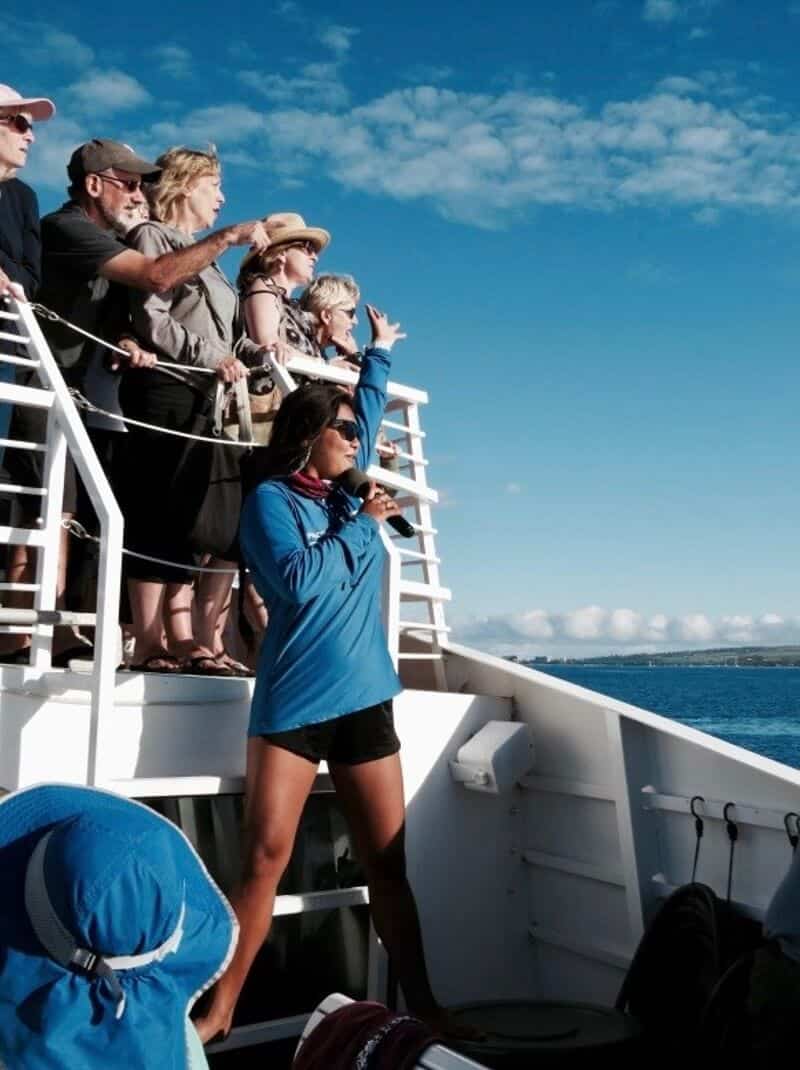
In order for both humans and animals to benefit from whale watching, environmental interpretation is crucial aboard any vessel dedicated to viewing whales and dolphins. Environmental interpretation occurs in natural settings where visitors are informed of the intrinsic values of a particular site’s resources and its overall relationship to human experience (Orams 2016). Interpretation involves highlighting the influence of human behavior on natural ecosystems while instilling love and respect for the animals. This redirected perspective can be quite powerful in sparking a commitment to conservation. Moreover, studies have shown that participants want to be educated with more than half of those engaged in wildlife viewing citing education as a driving factor in protecting wildlife (Zeppel 2008).To this end, some marine conservation organizations have recently developed global responsible eco-tourism certification programs. These programs enable operators to incorporate the highest standards for customer experience while ensuring that their practices do not result in excess stress or disturbance to the animals encountered (WCA). To date, the efficacy of these programs is largely unknown.
WATCH RESPONSIBLY!
Violating regulations not only potentially harms the animals, it hampers any opportunity to educate those involved about wildlife conservation and sustainability. Balancing heightened visitor experience and exceptional care of the animals involved is a slippery slope indeed. However, interpretive efforts are worth the work required. Studies have shown that empathy gained (via interpretation) during wildlife encounters can directly influence pro-conservation and environmentally sound behavior (e.g. adherence to guidelines) (Zeppel 2008). Ultimately, if the operators and crew prioritize education and interpretation in their offerings, they are more likely to self-enforce, which benefits the animal and observer alike.
The effectiveness of responsible whale watching is realized when a participant walks away informed, inspired and eager to undertake further conservation measures. This can be accomplished by a robust education and interpretation program aboard the vessel, as well as guidelines that inform the operator and crew on the importance of adherence.
In the next installment, we explore policies currently in place designed to ensure the safety and conservation of the animals involved. Stay tuned!
Sources
- Hoyt, Erich, and Parsons, E.C.M., The Whale-Watching Industry: Historical Development , Jan. 2014, pp. 57–70
- Forestell, Paul H., “If Leviathan Has a Face, Does Gaia Have a Soul?: Incorporating Environmental Education in Marine Eco-Tourism Programs”. Ocean & Coastal Management, vol. 20, no. 3, 1993, pp. 267–282
- Forestell, Paul H and Kaufman, G., Whalewatching in Hawaii Enhances Appreciation for Endangered Species and the Marine Environment 1990
- Zeppel, Heather, and Sue Muloin. “Conservation Benefits of Interpretation on Marine Wildlife Tours.” Human Dimensions of Wildlife, vol. 13, no. 4, 2008, pp. 280–294
- IAATO. “IAATO Cetacean Watching Guidelines.” International Association of Antarctica Tour Operators.
- International Whaling Commission Convention on the Conservation of Migratory Species of Wild Animals
- World Cetacean Alliance Global Best Practice Guidance for Responsible Whale and Dolphin Watching
- International Fund for Animal Welfare. “Whale Watching Worldwide Tourism Numbers, Expenditures and Expanding Economic Benefits.” Economists at Large, 2009, www.ecolarge.com/wp-content/uploads/2010/06/WWWW09.pdf.
- Orams, Mark, et al. “What’s in It for the Whales?” Whale-Watching: Sustainable Tourism and Ecological Management, by James Higham et al., Cambridge University Press, 2016, pp. 146–162.
- Senigaglia, V, et al. “Meta-Analyses of Whale-Watching Impact Studies: Comparisons of Cetacean Responses to Disturbance.” Marine Ecology Progress Series, vol. 542, 2016, pp. 251–263

